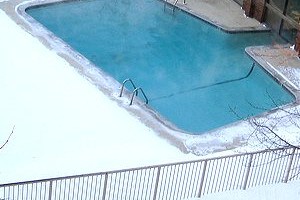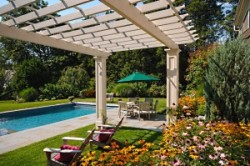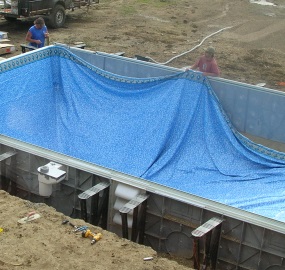
In the market for a pool? Replacing an old liner? Here are 8 things to consider when choosing a vinyl pool liner.
Color
Choosing a liner color you would think would just come down to personal taste but there are a few things to consider when selecting your liner color. Dark liners may help absorb heat and therefor warm your water up for you. Another plus is that they may hide some debris and not show dirt as much. However, the darker the liner, the more that liner will be susceptible to bleaching due to chlorine and sun. It is possible it may also age faster due to UV damage. Lighter liners on the other hand will not be as susceptible to bleaching and fading and may last longer due to less UV damage. They will show debris more than dark liners and will force you to stay on top of cleaning. From an aesthetic perspective, the natural aqua appearance somewhere in the medium color range may balance these pros and cons.
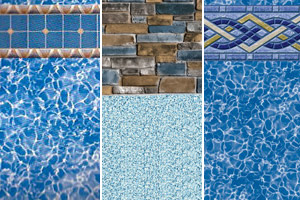
Vinyl swimming pool liners are available with many color options.
Pattern
Liners will likely have two different patterns. A boarder pattern and then the body of the pool will have a pattern. You may also have the option of a solid color. Things to consider when selecting pattern. Any type of pattern will help hide debris. However, a few things to consider when choosing your pattern is how well will seems line up? Most pools liners will have several places where it has been seemed together. If you choose a tile pattern, those seems may be really noticeable. If you choose a pebble pattern it won’t be as noticeable. Single light colors will show the seam more readily as well. There is also a wavy, swirl, or abstract pattern that has a nice reflective water appearance that sort of disappears into the background. That pattern provides the best camouflage of seems and gives a natural water appearance. Boarders will be your personal preference. You might want to consider the colors of your pool’s patio or surrounding area that maybe you want to pick up.
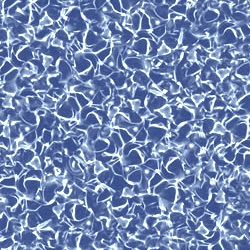
Wavy, swirl, abstract, water
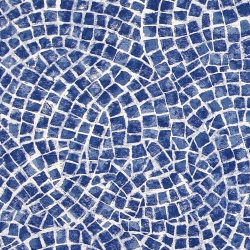
Tile, mosaic
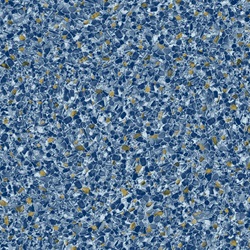
Pebble, stone

Solid, no pattern
Thickness
When choosing a vinyl swimming pool liner, thickness is important. A thicker liner is more durable, more puncture resistant, and less likely to leak over time.
While a thicker liner may seem like the better choice, there are a couple drawbacks. Thicker liners can be more difficult to install, as thicker liners are not as elastic (stretchy) as thinner liners. So, you may have more issues with the liner fitting in the corners and around any steps that may be in your pool. Thicker liners also tend to cost more, as more vinyl and manufacturing processes are used during their fabrication, plus the liner installer may charge a little more to install a thicker liner knowing they may be more difficult to install.
As for thickness, liners come in varying thicknesses such as 20 mil or 27 mil. The “mil” is a unit of thickness used in the swimming pool liner industry. The larger the mil number, the thicker the liner. 1 mil equals 1 one-thousandth of an inch, so:
1 mil = 1/1000 inch = 0.001
For a vinyl swimming pool liner:
20 mil = 0.020 inch
27 mil = 0.027 inch
Liner thicknesses usually range between 20 and 40 mil. Variations in the manufacturing process means that sometimes manufacturers err on the side of being slightly thicker to guarantee their liner meets the mil spec they post. So, a 20 mil liner might actually measure 0.0205 instead of 0.020.
What is gauge?
You might find some liner thicknesses are only shown in gauge. Guage is NOT equal to mil, and in the liner industry as the gauge number increases, so does the thickness. A 20 gauge liner is slightly *thinner* than a 20 mil liner. A 30 gauge liner is thicker than a 20 gauge liner. Always try to find out the mil thickness when comparing liners from different makers.
Floor versus wall thickness:
Be sure to ask about liner floor versus liner wall thickness. Some liners have a floor thickness thinner than the walls to save costs during manufacturing. Liners will show a thickness value such as 28 wall 20 floor, or 28/20.
Thicker liners will usually be more expensive, but there are some companies that have a handful of liners that you can get the 27 mil liner for the same price as a 20 mil liner. Thickness has no relation to the risk of the liner fading over time. How well your water is balanced (chlorine level, pH, etc) can affect fading. Discuss liner thickness with your local pool dealer when making this decision, as they will know what works best for your area.
Temperature
Depending on where you live there may be times when you should NOT replace your liner. You want to avoid installing liners on cold days, ideally the temp should be at least above 60 degrees Fahrenheit so that the liner is more flexible and pliable making it easier to install. Living in the cold climates this may mean you will need to wait until June or even July for the right time to install so be patient.
Ground water
Another consideration especially if you are replacing a liner is whether or not there is ground water around your pool. If you know that there is a high water table around your pool you will want to make sure that the ground water is low so that when you empty your pool the outside ground water pressure isn’t so great that it causes the walls of your pool to cave. Also make note of recent rains which temporarily raise your ground water.
Fixing problems
If you are replacing your liner, this may be an ideal time to consider replacing skimmer plates, jet fixings, pool lights, drain covers, etc. Inspect these items to determine if they are nearing the end of their life expectancy. If you have any major dents or places where you could see the underlying vermiculite was not smooth, it would also be a good time to re-trowel. Be sure to include these potential costs as you plan and budget for your liner project.
Life expectancy
A pool liner’s life expectancy is going to be determined by many factors. Chlorine, how well you have maintained your chemical balance (alkalinity/pH/etc) UV rays, freeze/thaw cycles, and whether you have a pool cover will all contribute to your liners life expectancy. Sunlight exposure is also a factor as vinyl degrades faster when exposed to UV rays. If you have a pool cover, this will greatly reduce the amount of UV exposure your liner receives. The location of your house, amount of tree cover also affect the exposure. Liners can last anywhere from 5 to 15 years with an average around 10 years. Prices depend on the size and type of liner you choose. Be sure to plan on this as a recurring expense associated with liner pools.
Don’t let your liner fail
A failed liner can result in bigger issues and expenses such as major leaks, damaging surrounding walls, and also leaving you pool-less for a longer period of time. Inspect your liner every year for weak spots, tears, wrinkles or any leaks. A wrinkling liner is a sign that your liner could be nearing end of life. Punctures are also a concern. Guests and pets are the number one cause of punctures. It may be fun to watch your dog jump and and climb out of the pool, but their nails can easily scratch and even puncture vinyl liners. Sharp and pointed toys should be avoided.
[sc:ad_Pool_Related_Google_300_x_250]